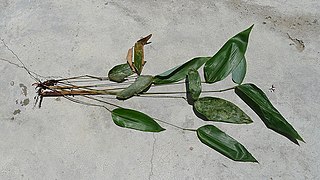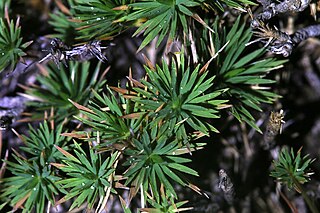
Olmeca is a genus of Mesoamerican bamboo in the grass family.

Chusquea is a genus of evergreen bamboos in the grass family. Most of them are native to mountain habitats in Latin America, from Mexico to southern Chile and Argentina.

Merostachys is a Neotropical genus of bamboo in the grass family. It is found in South America and Central America from Belize to Paraguay.
Myriocladus is a South American genus of bamboo in the grass family. It is found in the sandstone tablelands of Venezuela, Guyana, Suriname, and northern Brazil.

Rhipidocladum is a genus of New World woody bamboo in the grass family. It is found in Mesoamerica, Trinidad, and South America. The genus is characterized by having erect, non-pseudopetiolate culm leaves, numerous branchlets arising in an aspidate (fan-like) array, and by having true caryopses as fruit. The name is derived from the Greek rhipid meaning "fanlike" and clad meaning "branch".
- Rhipidocladum abregoensis - Colombia
- Rhipidocladum ampliflorum - Venezuela
- Rhipidocladum angustiflorum - Colombia, Venezuela
- Rhipidocladum bartlettii - Mexico, Belize, Guatemala, Honduras
- Rhipidocladum clarkiae - Costa Rica
- Rhipidocladum harmonicum - from southern Mexico to Bolivia
- Rhipidocladum martinezii - Mexico (Chiapas)
- Rhipidocladum maxonii - Costa Rica, Guyana
- Rhipidocladum neumannii - Argentina, Bolivia
- Rhipidocladum pacuarense - Nicaragua, Costa Rica
- Rhipidocladum panamense - Panamá
- Rhipidocladum parviflorum - Venezuela, Colombia, Perú, Bolivia, Brazil, Panamá
- Rhipidocladum pittieri - from Mexico (Michoacán) to Panamá
- Rhipidocladum prestoei - Trinidad
- Rhipidocladum racemiflorum - Mexico from Tucumán to Tamaulipas
- Rhipidocladum sibilans - Venezuela, Guyana

Guadua is a Neotropical genus of thorny, clumping bamboo in the grass family, ranging from moderate to very large species.

Gynerium is a monotypic genus of Neotropical plants in the grass family, native to Mexico and Colombia, Central America, South America, and the West Indies. It is classified in its own tribe Gynerieae.
Filgueirasia is a genus of Brazilian bamboo in the grass family.

Puelia is a genus of African grasses, the only genus in the tribe Atractocarpeae. It belongs to the subfamily Puelioideae, one of the early-diverging lineages in the grasses, but used to be considered a bamboo genus.
Reitzia is a genus of plants in the grass family.
Agenium is a genus of South American plants in the grass family.
Anthaenantiopsis is a genus of South American plants in the grass family.

Arthropogon is a genus of South American and Caribbean bunchgrass plants in the grass family.

Sucrea is a genus of Brazilian plants in the grass family.
- Sucrea maculataSoderstr. - Rio de Janeiro, Espírito Santo
- Sucrea monophyllaSoderstr. - Bahia
- †Sucrea sampaiana(Hitchc.) Soderstr. - Espírito Santo†

Olyra is a genus of tropical bamboos in the grass family. It is native primarily to the Western Hemisphere, with one species extending into Africa.
Guaduella is a genus of African plants in the grass family, the only genus in the tribe Guaduelleae. It belongs to the subfamily Puelioideae, one of the early-diverging lineages in the grasses, but used to be included in the bamboos.
- Guaduella densifloraPilg. - Nigeria, Cabinda, Cameroon, Republic of Congo, Gabon, Equatorial Guinea
- Guaduella dichroaCope - Cabinda
- Guaduella humilisClayton - Nigeria, Cameroon
- Guaduella macrostachys(K.Schum.) Pilg. - Ghana, Nigeria, Cameroon, Gabon
- Guaduella marantifoliaFranch. - Cameroon, Republic of Congo, Gabon
- Guaduella oblongaHutch. ex Clayton - Guinea, Sierra Leone, Ivory Coast, Cameroon, Republic of Congo, Gabon, São Tomé, Bioko

Homolepis is a genus of Neotropical plants in the grass family. They are native to Mexico, Central and South America, and the West Indies.

Micraira is the only genus of tribe Micraireae in the grass family, native to Australia.
Altoparadisium is a genus of bunchgrass plants in the grass family. The species are native to Brazil and Bolivia in South America.
Canastra is a genus of bunchgrass plants in the grass family. Its species are endemic to Brazil.












